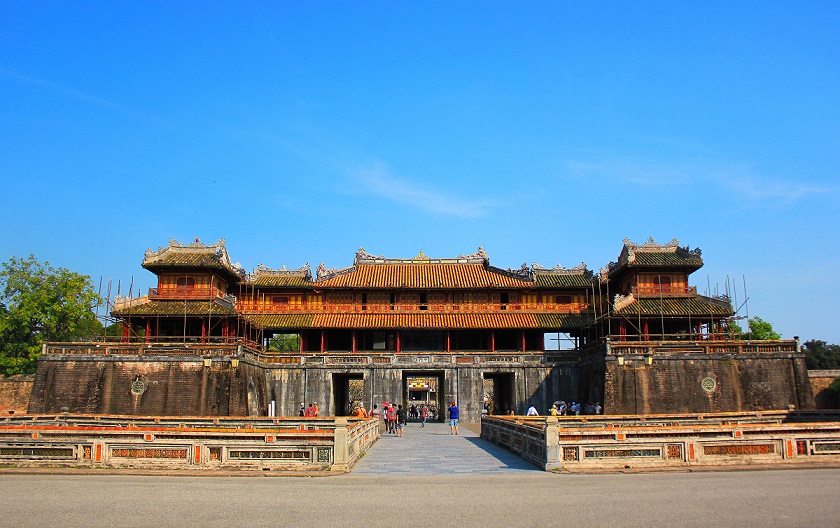
A traveller’s guide to visiting Hue
A Vietnam travel plan usually means urban visits to Ho Chi Minh and Hanoi, or the outlying beautiful locations of Halong Bay and Hoi An. However, tourists cannot afford to miss out on the most historical place of Vietnam, Hue, which resonates of stories of the medieval pre-Communist past.
Hue – the ancient Imperial City of Vietnam
Hue was established as the capital of the Vietnam in 1802 as the political, cultural and religious seat of the Nguyen dynasty until 1945. Today Hue is a combination of the Hue Citadel, the Imperial City, the Imperial Residence, the Forbidden Purple City and the Inner City, making this feudal city a place of great historical relevance. The purple-tinged stonework of the Hall of Supreme Harmony has perhaps given Hue the epithet of the “Forbidden Purple City”.
Outside Hue there are other historical monuments and ritual sites - the Van Mieu (Temple of Literature), the Dan Nam Giao (Esplanade of Sacrifice to the Heaven and Earth), the Ho Quyen (Royal Area), the Den Voi Re (Temple of the Roaring Elephant), and the Chua Thien Mu (Celestial Lady Pagoda).
When to go to Hue city
Anytime during the dry months is a good time to visit Hue. However, if you can time your visit to coincide with the Hue Festival usually held in April, you can witness Vietnamese tradition and heritage in its true spirit.Generally, February to April is a good time, to avoid the hot, humid weather.
What to see in Hue city
Hue is the best city to experience Vietnamese history, culture and tradition.
The Hue Citadel are the structure of four citadels that make the Capital City - Hoang Thanh /Imperial City that houses the royal palaces and shrines, Tu Cam Thanh / the Forbidden Purple City that was the former royal residence, Dai Noi / the Inner city and Tran Binh Dai. As it extends over a large area, you can take a taxi or hire a bicycle to explore the site.
The historical Thai Hoa Palace was the Royal Meeting and Ceremonial Hall, and is a popular tourist attraction today.
The Hue Antiques Royal Museum, formerly Khai Dinh Museum, houses an extensive collection of royal treasures. It is a must-visit, for the amazing oriental artefacts of the royal period.The museum showcases Vietnam’s handicraft, paintings, literary works, made by Hue artisans during the medieval period. These remarkable works use a wide range of materials such as gold, silver, jade, ivory, glass, stone, wood, leather, fabrics, paper, bamboo, rattan and terra cotta. The museum is a true combination of history, royalty and the region’s rich tradition of arts and crafts.
There are seven Royal Tombs near the city of Hue. Of these the tombs of Minh Mang, Tu Duc, and Khai Dinh are more popular with the tourists. These tombs are elaborate structures, and fine example of architectural fusion.
Thien Mu Pagoda is a towering 7-tiered temple perched on a hill overlooking the Perfume River. Also known as the Pagoda of the Celestial Lady, the temple dates back to the early 17th century. The temple has inspired many folk rhymes and is symbolic to Hue. It is a must-see for its architectural splendour and magnificence.
The The Mieu is a beautiful ancestral temple dedicated to the former rulers of the city, constructed by King Minh Mang in 1823. Highlights are the nine urns in front of the temple, dedicated to the royal ancestors.
The Thanh Toan Bridge is another dated historical construction visited for its architectural beauty. Visit at night when it is lit up and looks magnificent.
The Bach Ma National Park is a national park, rich in biodiversity that you may like to visit.
What to do in Hue city
Royal Banquet dinners are a recent tourist attraction which allows you a retro look into the medieval culture of Hue dynasty. Dress up as Vietnamese royalty and dine on traditional dishes that have a Royal influence while you listen to traditional music.
A bike ride through the countryside lets you explore the tombs in the outlying areas and the picturesque landscape of the river, while you enjoy Hue cuisines and watch royal enactments.
A dragon boat cruise down the Perfume River is a fine way to see the region and traditional settlements. The river gets its name from the various orchards flanking the river banks that lend a flowery perfume to the river.
Visit the ancient Dong Ba Market and pick up some of the fresh Southeast Asian fruits you will not find elsewhere - custard apple, gac, or durian. Buy a Vietnamese conical hat and try to get your tour operator take you to those villages where conical hats and incense sticks are handmade.
Visit the Lang Co Beach to relax and cool off. However, get yourself a lifeguard, as the waters can get choppy.

